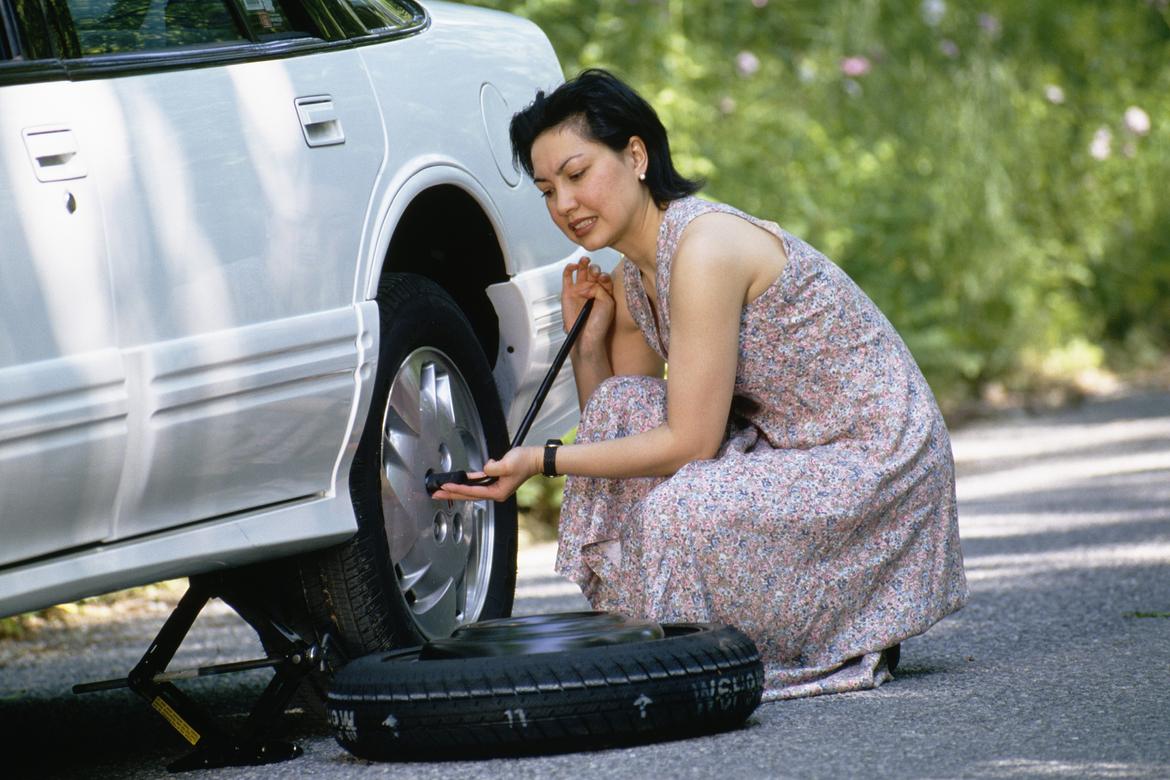
A flat tire is by far the most common unexpected mechanical problem that completely disables a car. Driving on a completely flat tire can cause wheel damage, which can cost you more in the long run, so mount the spare or get roadside assistance. Along with the vehicle being damaged, the flat tire can cause an accident, injury, or even death to the passengers in the vehicle or those around the vehicle.
It is important to pull over immediately because while some flat tires are able to be repaired, continuing to drive on a flat tire will quickly ruin your tire.
The most common cause of a flat tire is puncturing of the tire by a sharp object, such as a nail, letting air escape. The scariest form of a flat tire is a rapid loss of pressure or a blow-out. Changing a flat tire can also be dangerous if done alongside a busy road (especially at night).
How to Safely Change a Tire
When one of your tires goes flat, your first order of business should be to steer to a safe location for changing it. Because driving more than a short distance can destroy a tire and damage the wheel, the sooner you get off the road, the better. On the other hand, you don’t want to try to change a tire with your body sticking out into traffic, or on soft, uneven ground; it’s better to sacrifice a tire and wheel than risk your safety.
Even if you decide to call for roadside assistance, it’s best to get as far away from traffic as you can. If you have to wait on a road shoulder, get out of the car and wait away from traffic if you can. The engine should be off, and all passengers should be out of the vehicle while a tire is being changed.
Before you start to change a flat, set the parking brake, turn on your hazard lights and, if you have roadside warning triangles, place them where oncoming traffic will see them. If you have wheel blocks, they should be placed on both sides of the tire that’s diagonally across from the afflicted tire.
Next, check the owner’s manual for instructions on locating and using the jack, and for any guidance specific to your car. Even if you’ve changed several tires before you could probably benefit from a quick refresher course.
The lug nuts holding the flat tire to the car should be loosened with the wrench on the jack handle before lifting the tire off the ground. Don’t remove the nuts yet, just loosen them enough that you can turn them by hand.
Follow the manufacturer’s instructions for where to place the jack. The owner’s manual should have illustrations showing where your jack points are, and those points often have a notch or other mark you can see or feel. Use the jack to lift the wheel high enough that it’s off the ground, and keep your arms and other body parts away from the underside of the car in case it slips.
Once the tire is jacked up, remove the lug nuts and flat tire and install the spare tire, which on most vehicles will be a compact, temporary one. Replace the lug nuts until hand-tight, then give them about a quarter turn with the wrench.
Slowly lower the car to the ground until the jack easily slips out. Tighten the lug nuts with the wrench in a crisscross pattern. Though you want the nuts to be tight, don’t play Hercules. Snug them down once, then go around again in a crisscross pattern until they feel equally tight and require some effort to loosen.
If you have a tire pressure gauge, this would be a good time to use it to check the spare, which may have been hibernating in the trunk for years and thus could be low on air. Most compact spares are supposed to be inflated to around 55 or 60 pounds of air, and many gauges don’t read pressure that high, so you should find a repair shop or tire dealer soon that can check for you.
With temporary spares, manufacturers generally recommend driving less than 55 mph and fewer than 100 miles — they mean it when they say “temporary” — so do your best to abide by those rules. Because they’re smaller than regular tires, temporary tires won’t have the same ride and handling characteristics as your normal tires and may give different speedometer readings. They might also initially trigger traction control and/or antilock brake warning lights.
Repairing or changing a flat tire can be dangerous and should be handled by specially trained personnel. In cases where a small mechanical problem or flat tire have you stranded, you can contact Mobile Mechanic Melbourne Pros for assistance.
The post How To Change Your Flat Tire Alone and Safely appeared first on Mobile Mechanic Pros.

No comments:
Post a Comment